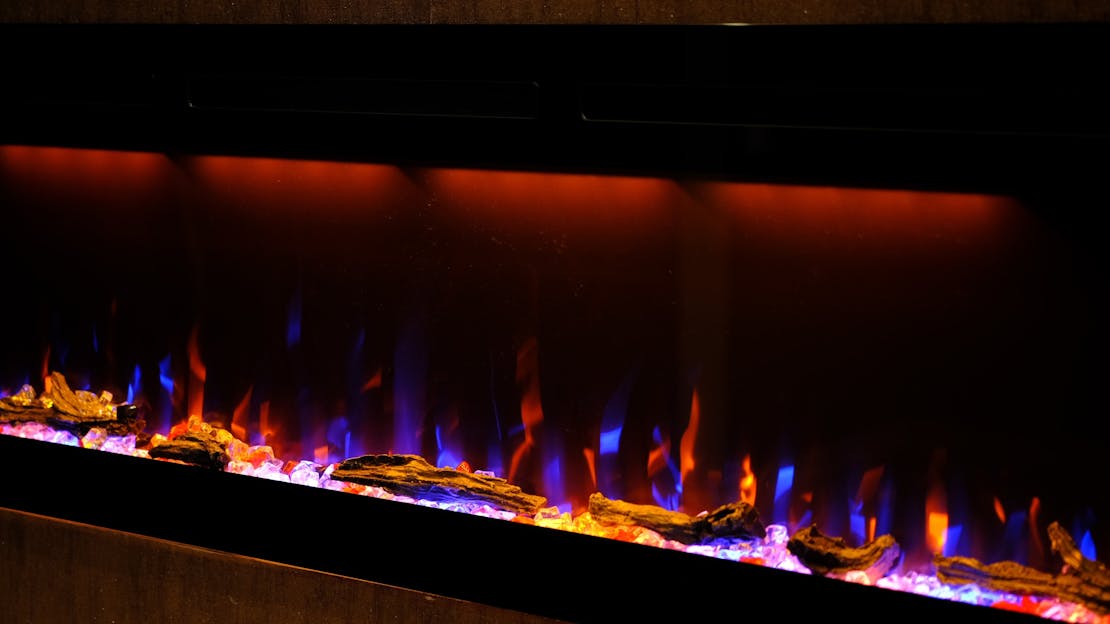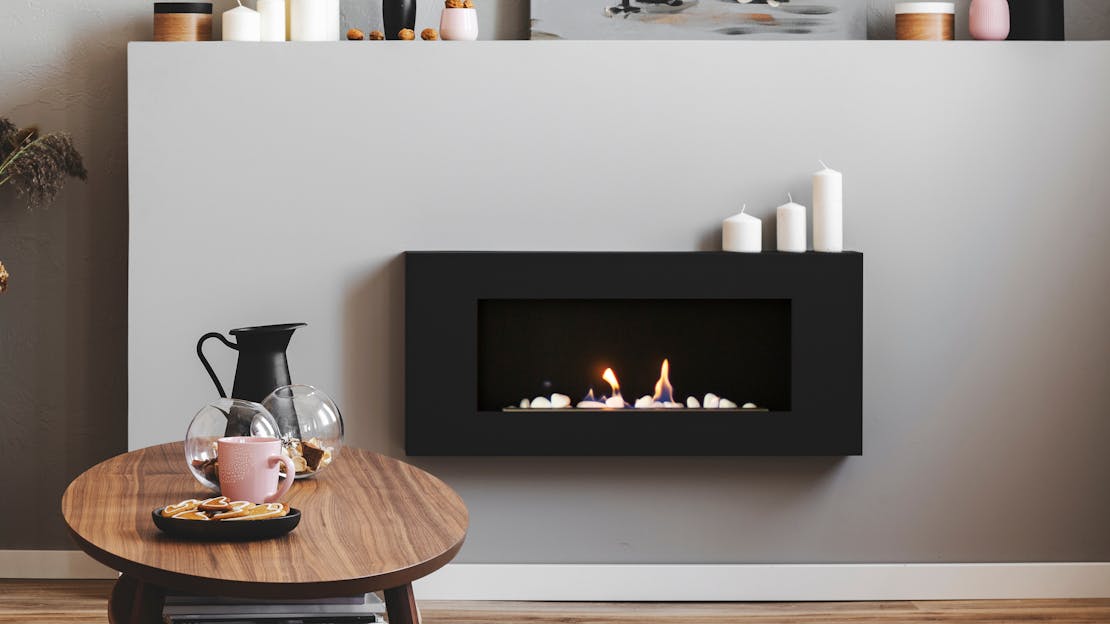
The Ultimate Guide for Electric Fires
Welcome to our guide on electric fires, your comprehensive resource for contemporary heating solutions that blend warmth and ambiance. Whether you're new to electric fires or looking to upgrade, this guide equips you with essential insights. We'll delve into the mechanics of electric fires, their advantages, installation guidance, safety considerations, and more.
What is an electric fire?
An electric fire is a heating appliance that uses electricity to produce warmth and often includes simulated flames for decorative purposes. It is designed to replicate the appearance and, in some cases, the ambiance of a traditional wood-burning or gas fireplace without the need for a real fire, chimney, or ventilation. Electric fires typically consist of a heating element, such as a coil or ceramic element, and LED lights to create realistic flame effects. They are usually controlled by a remote or a control panel, allowing users to adjust the heat output and flame appearance. Electric fires are a popular choice for heating and adding visual appeal to homes, as they are convenient, energy-efficient, and require minimal maintenance.
Why would I use an electric fire?
Convenience: Electric fires offer exceptional convenience. They typically come with straightforward controls, such as a switch or remote control, making it effortless to switch them on and off. Unlike traditional wood or gas fireplaces, there's no need to handle logs, clean ashes, or tend to the fire. This convenience is especially appealing for those seeking a hassle-free heating and ambiance solution.
Energy Efficiency: Electric fires are renowned for their energy efficiency. They have a high energy-to-heat conversion rate, meaning that a significant portion of the electricity they consume is converted into heat. Unlike wood-burning fireplaces that lose heat through the chimney, electric fires direct the heat into the room, making them an efficient heating choice.
No Emissions: Electric fires are environmentally friendly because they produce no harmful emissions or pollutants. Unlike traditional wood or gas fires, there's no release of carbon monoxide, particulate matter, or other pollutants into the atmosphere. This makes electric fires a clean and sustainable heating option.
Safety: Electric fires are designed with safety in mind. They pose a lower risk of hazards compared to open flames, such as sparks, embers, or accidental burns. This makes them particularly safe for homes with children and pets, providing peace of mind for homeowners.
Versatility: Electric fires are highly versatile when it comes to installation. They can be placed in various locations within your home, including apartments and houses without chimneys. Additionally, they come in a wide range of styles and sizes, allowing you to choose a design that complements your interior décor and meets your heating needs.
Cost-Effectiveness: Electric fires can be cost-effective to operate. They typically have lower maintenance requirements compared to wood or gas fireplaces, which often require chimney cleaning and fuel replenishment. Additionally, electricity is often more affordable and readily available than other fuel sources, leading to potential cost savings in the long run.
Ambiance: Many electric fires come equipped with realistic flame effects. These effects create a cosy and inviting atmosphere in your home, even if you don't necessarily need additional heat. The visual appeal of the flames adds a charming touch to your living space, enhancing its overall ambiance.
Zone Heating: Electric fires allow for zone heating, which means you can target specific areas of your home for heating. This can be particularly beneficial for reducing energy costs because you can heat only the rooms you're using, rather than the entire house. It's an energy-efficient way to stay warm and comfortable.
In summary, you might choose to use an electric fire due to its unmatched convenience, energy efficiency, safety features, versatility in installation, cost-effectiveness, ambiance-enhancing flame effects, and the ability to provide targeted heating where and when you need it.
Are electric fires expensive to run?
Electric fires are generally considered to be cost-effective heating options. Their efficiency in converting electricity into heat is a key factor in their affordability. When you operate an electric fire, a significant portion of the energy consumed is directly converted into warmth for your space, with minimal heat loss. This efficiency ensures that you get the most out of the electricity you use, contributing to cost savings.
Unlike traditional wood or gas fires, where heat can escape through the chimney or flue, electric fires direct all the generated heat into the room. This means there's no wasted heat, which is another aspect that helps keep running costs lower compared to some other heating methods.
One of the advantages of electric fires is their ability to provide zoned heating. You can target specific areas of your home for heating, which can result in energy savings. For instance, you can choose to heat only the rooms that are in use while leaving others unheated. This flexibility allows you to avoid unnecessary energy consumption.
Many electric fires come with thermostatic controls that enable you to set a desired temperature. Once the room reaches that temperature, the electric fire can automatically adjust its heat output or switch off. This feature helps prevent excessive energy usage and ensures that the room remains at your preferred comfort level.
It's worth noting that the cost of electricity can vary depending on your location and electricity provider. Therefore, when assessing the running costs of an electric fire, it's essential to consider the local electricity rates. Additionally, electric fires typically require minimal maintenance compared to wood-burning or gas fireplaces, which may need regular cleaning, fuel replenishment, or chimney maintenance. The reduced maintenance can translate into cost savings over time.
Furthermore, some electric fires offer realistic flame effects for ambiance, and these effects can often be used without activating the heating function. This allows you to enjoy the visual appeal of a fire without significantly impacting your energy bills. While electric fires can be cost-effective to run, the actual running costs will depend on factors such as the model's energy efficiency, your local electricity rates, the duration and frequency of use, and how well you manage the heating to suit your needs. Therefore, it's advisable to check the product specifications and calculate estimated running costs based on your specific circumstances to get a clearer picture of the expense.
How do electric fires work?
Electric fires function by utilising electricity to generate heat and often incorporate simulated flames for decorative purposes. The operation can be broken down into several key steps:
Heating Element: At the core of an electric fire lies a heating element. This element is typically constructed from materials such as metal coils or ceramics, which possess high electrical resistance. When an electric current flows through these elements, they rapidly heat up.
Electricity Supply: The electric fire is connected to a standard electrical outlet or power source using a cord. When the electric fire is switched on, it draws electrical power from this source.
Thermostat Control: Many electric fires feature a thermostat control, allowing users to set their desired temperature. Once the room reaches the chosen temperature, the thermostat manages the heating element to sustain that level of warmth. This helps prevent overheating and excessive energy consumption.
Fan or Blower: Some electric fires include a built-in fan or blower that aids in distributing the warm air into the room. This fan circulates air over the heated element, causing it to heat up and subsequently circulate throughout the room. This process ensures even heating.
Simulated Flames: Electric fires often incorporate realistic flame effects created using LED lights. These lights are strategically positioned to emulate the appearance of flames. When the flame effect is activated, the LEDs produce a gentle flickering glow, enhancing the room's ambiance. Importantly, these flames are simulated and do not produce actual heat like a real fire.
Control Panel or Remote: Electric fires are equipped with either a control panel on the unit itself or a remote control. This allows users to adjust various settings, including heat output, flame intensity, and flame effect, without the need to physically interact with the appliance.
Safety Features: Electric fires are designed with safety in mind. They typically include features such as automatic shut-off timers, which can turn off the unit after a set period, and cool-touch surfaces to prevent accidental burns.
Visual Display: The flame effect and sometimes even the heating element are often displayed behind tempered glass or plastic front panels. This adds an extra layer of safety and helps protect against accidental contact with hot components.
In summary, electric fires operate by using electricity to power a heating element that produces heat. Some models also feature a fan or blower to distribute warm air evenly. Simulated flames, created by LED lights, add to the aesthetic appeal, and control options allow users to customise settings for both heating and ambiance. These appliances are designed with safety and ease of use in mind, making them a convenient and versatile heating solution for homes and other indoor spaces.
Will an electric fire heat a room?
Yes, an electric fire can effectively heat a room. Electric fires are available in various sizes and models, each with specified heating capacities measured in watts or BTUs. Many models feature thermostat controls for setting and maintaining a desired room temperature, while some include fans or blowers to distribute warm air evenly. Electric fires allow for zoned heating, making them energy-efficient by targeting specific areas. Their energy efficiency, combined with their heating capabilities, makes them suitable for smaller to medium-sized rooms, although their effectiveness may vary based on room size and insulation. Additionally, some models prioritise visual ambiance over heating efficiency, offering both warmth and an appealing aesthetic to the room.
Do electric fires need a flue?
No, electric fires do not require a flue or chimney. Unlike traditional wood-burning or gas fireplaces, which produce combustion by-products that need to be vented through a flue or chimney, electric fires generate heat and flame effects using electricity and do not produce any harmful emissions. This makes them a convenient and versatile heating option for a wide range of indoor spaces, including homes without chimneys or flues. Electric fires are designed for easy installation by simply plugging them into a standard electrical outlet, making them a suitable choice for various room configurations and settings.
How do you install electric fires on the wall?
To install an electric fire on the wall, first, choose a suitable location near an electrical outlet, considering aesthetics and heating efficiency. Assemble the provided wall-mounting bracket or kit, and, if needed, locate wall studs using a stud finder. Secure the bracket to the wall, ensuring it's level and firmly anchored with screws and wall anchors or plugs. Hang the electric fire unit on the bracket following the manufacturer's instructions, and secure it in place. Plug the unit into the electrical outlet, conceal the cord neatly, and test its operation. Maintain safety precautions, such as providing adequate clearance from combustible materials, and always refer to the manufacturer's installation manual for model-specific instructions.
![Are electric fires expensive to run?]() Electric Fire Buying Guides
Electric Fire Buying GuidesThe cost of operating an electric fire depends on several factors, including the wattage of the fire, local electricity rates, and how frequently and for how long you use it. In this guide we cover some things to consider.
![What are the requirements for an electric fireplace?]() Electric Fire Buying Guides
Electric Fire Buying GuidesThe requirements for an electric fire can vary depending on factors such as safety standards, but this guide will cover some general considerations.
![Five Tips for a Cosier Home this Christmas]() Electric Fire Buying Guides
Electric Fire Buying GuidesChristmas is on the way, with mere weeks to go until 25 December. If creating a cosy ambience in your home is on your agenda ahead of the arrival of Santa, we’ve compiled some top tips to help you do just that. Read on…
![Electric Fires: A Guide]() Electric Fire Buying Guides
Electric Fire Buying GuidesWith winter well and truly in full swing, your thoughts will have already turned to how best to heat up your house. From central heating to log burners and everything in between, there are a host of options when it comes to staying toasty at home.




